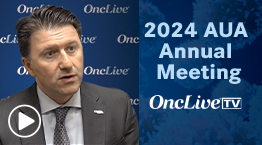Prexigebersen–Based Therapy Induces High CR/CRi Rates in Newly Diagnosed, Relapsed/Refractory AML
Prexigebersen in combination with decitabine and venetoclax demonstrated potent antitumor activity when used in the treatment of patients with newly diagnosed and relapsed/refractory acute myeloid leukemia.

Prexigebersen in combination with decitabine and venetoclax (Venclexta) demonstrated potent antitumor activity when used in the treatment of patients with newly diagnosed and relapsed/refractory acute myeloid leukemia (AML), according to interim data from stage 2 of an ongoing phase 2 trial (NCT02781883).1
In the newly diagnosed population (cohort 1) of 14 evaluable patients with high-risk and/or secondary AML (29%), 12 (86%) achieved complete remission or CR with incomplete hematologic recovery (CR/CRi) and 2 (14%) achieved partial remission (PR), comparing favorably with historical CR/CRi rates of 62% with venetoclax plus decitabine.
In the relapsed/refractory population (cohort 2), of 14 evaluable patients with high risk and/or secondary AML (15%), 8 (57%) achieved CR/CRi, 2 (14%) achieved PR, and 3 (22%) achieved stable disease, translating to an objective response rate of 93%. The 57% CR/CRi rate in this population also outperformed historical CR/CRi rates of 21% in patients treated with venetoclax and decitabine in this setting.
In both cohorts, prexigebersen was well tolerated, and adverse effects (AEs) were comparable with those of venetoclax plus decitabine.
Additional data will be shared as final efficacy analyses are conducted. Based on this analysis, Bio-Path, the developer of prexigebersen, plans to pursue FDA expedited programs for fast track and breakthrough therapy designations.
“We are delighted to report these positive interim data as they represent a potential breakthrough for these very sick patients who face a complicated disease with limited treatment options,” Peter Nielsen, president and chief executive officer of Bio-Path Holdings, stated in a news release. “Based on these favorable results, we plan to file for regulatory designations that could accelerate our ability to bring this potentially lifesaving therapeutic to patients with the greatest of unmet medical needs.”
Prexigebersen is a neutral liposome designed with nuclease-resistant, hydrophobic P-ethoxy antisense oligodeoxynucleotides targeted to Grb2 mRNA. Grb2 is an adaptor protein that binds oncogenic tyrosine kinases with downstream kinases, such as ERK and AKT, which are necessary components of cell growth and survival.
Stage 2 of the multicenter, open-label phase 2 trial consists of 3 cohorts: newly diagnosed patients who will receive treatment with the triplet; relapsed/refractory patients who will receive the triplet; and relapsed/refractory patients who are resistant or intolerant to venetoclax, and who will receive prexigebersen plus decitabine.
Notably, to be eligible for inclusion in cohort 1 patients must be ineligible for or unwilling to receive intensive induction therapy based on medical reasons, disease characteristics such as genetics, type of AML, or participant characteristics such as age, performance status, comorbidities, organ dysfunctions, or patient election of low-intensity treatment. Across all cohorts, patients must be eligible for venetoclax and decitabine therapy, based on investigator assessment.
Efficacy of the triplet will serve as the primary objective of the study and will be measured by CR, CRi, and CR with partial hematologic recovery.2 Prexigebersen-based treatment will be compared with historical responses reported with venetoclax and decitabine and intensive chemotherapy in the frontline and relapsed/refractory settings, respectively.
Secondary end points will include safety, pharmacokinetics, minimal residual disease assessment, partial remission and blast count reductions, and overall survival.
Of the 14 patients with newly diagnosed AML, all had received at least 1 cycle of the prexigebersen, decitabine, and venetoclax regimen. The median patient age was 75 years, and all were adverse risk by 2017 European Leukemia Net (ELN) guidelines (n = 10) or had secondary AML (n = 4).
Similarly, all 14 patients with refractory/relapsed AML had been treated with at least 1 cycle of the prexigebersen, decitabine, and venetoclax regimen. The median patient age was 56.5 years, and all were adverse risk by 2017 ELN guidelines (n = 11) or had secondary AML (n = 2).
Operations in the United States will continue as planned, with between 6 and 10 treatment sites. In addition, Bio-Path is determining whether to open enrollment for stage 2 of the phase 2 trial in Europe, where more patients may be eligible for inclusion in the study, thereby accelerating the forecasted completion and readout of trial milestones.
References
- Bio-Path Holdings announces positive results from interim analysis of phase 2 clinical trial of prexigebersen in acute myeloid leukemia. News release. Bio-Path Holdings, Inc. August 1, 2023. Accessed August 1, 2023. https://www.globenewswire.com/news-release/2023/08/01/2715632/0/en/Bio-Path-Holdings-Announces-Positive-Results-from-Interim-Analysis-of-Phase-2-Clinical-Trial-of-Prexigebersen-in-Acute-Myeloid-Leukemia.html
- Clinical trial of BP1001 in combination with venetoclax plus decitabine in AML. ClinicalTrials.gov. Updated March 28, 2023. Accessed August 1, 2023. https://classic.clinicaltrials.gov/ct2/show/NCT02781883



